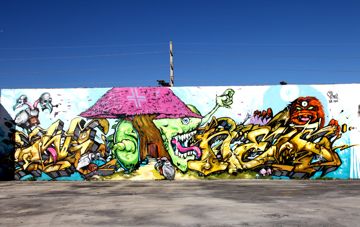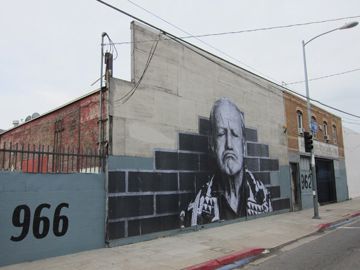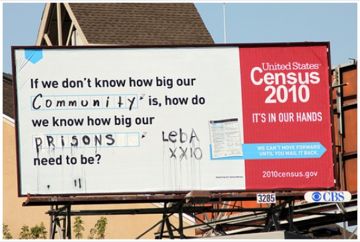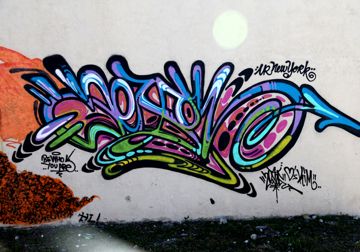Students often have lots of interest and questions about graffiti, graffiti art and street art. My response usually includes the fact that I love graffiti art and street art, especially if the artist takes their time to make something that’s really well designed (and in some cases has permission to create it). From my perspective, you can’t make a quality work of art in a few seconds while simultaneously looking over your shoulder for the cops. That’s where I draw the line between art and vandalism. Vandalism includes tagging/defacing a space that the artist knows will have to be washed off immediately (store windows, front doors of businesses, subway token booths, etc.). Fortunately, most graffiti artists create works in spots that can linger for a while. And some linger for a long, long time, which is great if they are well done, whether they exist as an artist’s tag or as a painting that includes the artist’s tag.
Barry McGee and the late Margaret Kilgallen are featured in season 1 and address the idea of graffiti as an art form- an art form where you see the artist’s hand in the work vs. things like billboards, which Margaret Kilgallen calls “mind garbage”. Barry McGee goes on to make the point that graffiti can simply be painted over with a roller- something you cannot do with a really bad commercial jingle that stays in your head.
There are literally tons of books and sites that help us teach about graffiti as an art form, even Banksy’s Exit Through the Gift Shop has been nominated for an Oscar at this point, but three resources I want to point out this week include two websites- The Dirt Floor and Brooklyn Street Art– and the film Bomb It.
The Dirt Floor gives you a rolling update on street art in and around Los Angeles. The creators of the site describe it this way:
The Dirt Floor is a leading contemporary and underground arts and culture magazine dedicated to surfacing the best of street, underground art, and pop culture in its many forms. We believe that art is a lifestyle and the solution to all problems. We are low value with high purpose. We are dedicated to non-educational activities, self indulgent thoughts, unfinished and incomplete actions. Our work is not easily classified or marketable. This protects us from analysis, judgment or criticism. We have no direction, motivation other than a cursed reflex to purge our anonymous mental overflows in a public forum and then run away from it and hide behind our cloak of digital anonymity.
Brooklyn Street Art is described as:
…the new creative spirit that runs in the streets, the artist studios, and galleries of New York and beyond. New hybrids, new techniques, and new mediums are expanding the definition of public art, street art, graffiti, and urban art; each vying for the attention of passers-by. As trends develop in the street, we watch to see how they affect popular culture and the rest of the art world.
Jon Reiss’s Bomb It is over 90 minutes of graffiti art education that features dozens of characters who give the inside, outside and upside-down scoop on what makes graffiti art in the first place. Viewers will be introduced to Cornbread, Tracy 168, Revs and others. While it has its share of profanity laced throughout the commentary and may not be suitable for the classroom in some cases, there is plenty of history and BEAUTIFUL shots that make this a worthwhile film to see.
Teaching with contemporary art involves acknowledging that students have an interest in what pushes the boundaries of art and even of what’s legal. Bringing the subject of graffiti into the classroom allows for not only some beautiful work, it also allows for deep conversation about what art can be, how some artists choose to make their work, and even whether graffiti artists would consider themselves artists in the first place. But I would encourage a combination of layered discussion that teaches about and fuels graffiti art vs. simply working in a style that looks like graffiti. For starters, weren’t cave painters the first graffiti artists??









Pingback: What I Learned at the Armory Show | Art21 Blog
Pingback: Glenn Ligon, Ai Weiwei and The Art Cops | Art21 Blog
Pingback: Media 2: Exit through the Gift Shop | K-12 Curricular Materials
Pingback: Exit through the Gift Shop | K-12 Curricular Materials
Pingback: Students used to learn that graffiti is a criminal form of vandalism, and they are now taught that it is an art form? | AEIdeas